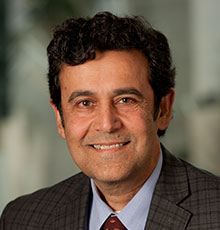Oregon Pilot Program Would Expand MH Crisis Services for Youth
Abstract
The implementation of 988 allowed many states to bolster their mental health crisis services, but quite often those efforts are focused on adults. A program in Oregon would set up a pilot to connect youth statewide with crisis services.
In large states, the goal of establishing a robust, statewide mental health crisis system often runs into the same problem: distance. In Oregon, roughly 80% of the youth experiencing a psychiatric crisis present to three hospitals that are largely well equipped to treat them, explained Robin Henderson, Psy.D., chief executive of behavioral health with Providence Oregon. But what happens to the 20% of kids who present at the other dozens of rural hospitals across the state?

The proposed pilot in Oregon will aim to empower hospitals and the communities around them to collaborate to create a range of local services and supports for youth in crisis, says Ajit Jetmalani, M.D.
“Very often, children will need to travel to Portland for acute psychiatric emergencies, or they will sit in emergency rooms in a rural setting that has no services at all and just wait,” said Ajit Jetmalani, M.D., director of the Division of Child and Adolescent Psychiatry and the Joseph Professor of Child and Adolescent Psychiatry Education at Oregon Health & Science University.
Jetmalani and Henderson are proposing a pilot program in Oregon that would harness the momentum created by the implementation of 988 to significantly improve access to care for youth in crisis statewide. The program would use Oregon’s existing regional trauma system for physical health crises, which assigns levels (between one and four) to the state’s more than 60 hospitals. The system allows hospitals to coordinate, ensuring patients are connected to the hospital with the most appropriate level of care. The proposed pilot would use that same system and apply it to youth mental health crises.
“If you get in a motorcycle accident in Baker City, that little hospital in Baker City knows exactly what to do,” Henderson said. “They have a playbook. They know where to send you, how to stabilize you, and these things can happen very quickly. But if a child psychiatric crisis shows up, they would end up reinventing the wheel every time. What we are proposing is to take a page from the playbook of a successful, regionalized crisis system and apply that to mental health.”
Under the pilot program, one hospital in each region would have a Regional Child Psychiatric Center within its emergency department (ED). The centers would have comprehensive mental health services including access to child/adolescent psychiatrists and other licensed mental health professionals, as well as family/peer support. Other hospitals in that region would have a memorandum of understanding with the Regional Child Psychiatric Center for remote consultation services, as well.
“We’ve seen that if you can deliver high-quality assessments and interventions in the emergency room, you can oftentimes resolve crises and create a safe plan for care in the community,” Jetmalani said. “We’re hoping this program will make it easier for all kids to have access to those types of services, regardless of where a child presents.”
Jetmalani and Henderson worked with Rep. Tawna Sanchez, a Democrat who represents parts of northern Portland, to introduce legislation into Oregon’s legislative session this year. The legislation includes funding for the next two years to get the pilot started, which would fund the development of three Regional Child Psychiatric Centers, including up to three Child/Adolescent Psychiatric Emergency (CAPE) units.
The CAPE units are emergency evaluation areas with between four and eight beds. When the ED assessment determines there are no physical health issues, youth and their families can transition to a CAPE unit, where they can stay for up to three days for stabilization or observation. The CAPE units give patients, families, and professionals time to determine what the child needs and what may be driving the crisis in a safe environment, separate from a loud and busy ED.
“The CAPE unit is a setting built specifically for supporting youth who are in crisis,” Jetmalani said. “We can implement trauma-informed practices and immediately work on pulling services together for the child and family, ensuring that they have support in the community and a safe place to go.”
Henderson and Jetmalani are hoping that the funding included in the legislation will get the program up and running, allow them to show lawmakers that it works, and then allow them to expand so each region has a Regional Child Psychiatric Center. They aim to eventually make the program scalable so other states can implement it.
The two-year period also allows more time to determine the best payment structure for the program, Henderson said. “There are schools of thought that say we should use a telecommunications tax to pay for these services,” she said. It could also potentially be paid through insurance.
“First, we need to see what our experiences are. How many people are using these units? What kind of capacity issues do we have?” Henderson said. “This shouldn’t just be paid for by Medicaid. It should be paid for by all insurers. But we need to figure out what that’s going to look like.” ■



